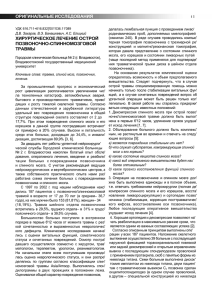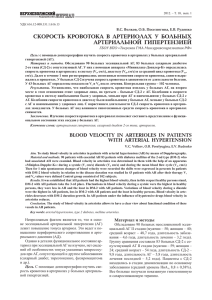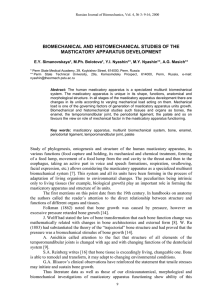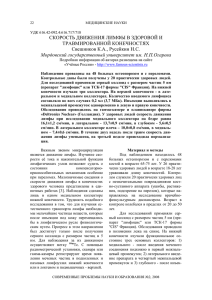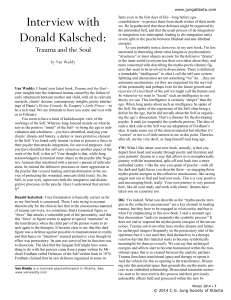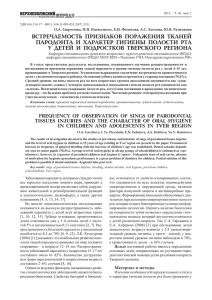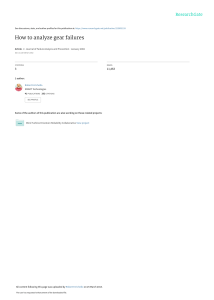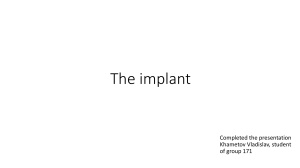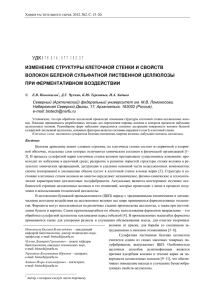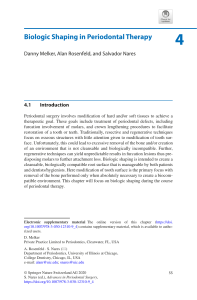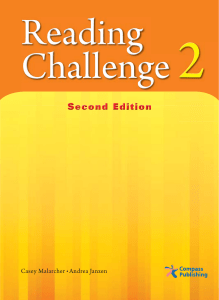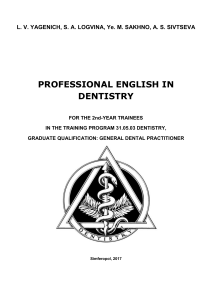BIOMECHANICAL INVESTIGATION OF A TRAUMA OF THE UPPER
реклама
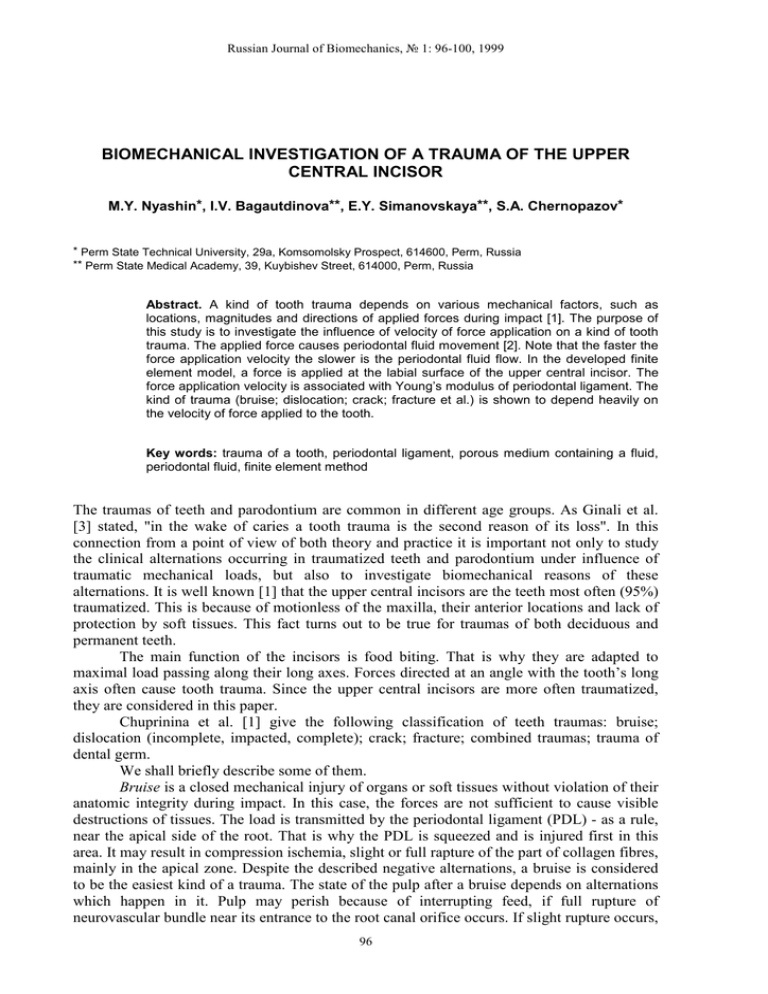
Russian Journal of Biomechanics, № 1: 96-100, 1999 BIOMECHANICAL INVESTIGATION OF A TRAUMA OF THE UPPER CENTRAL INCISOR M.Y. Nyashin*, I.V. Bagautdinova**, E.Y. Simanovskaya**, S.A. Chernopazov* * Perm State Technical University, 29a, Komsomolsky Prospect, 614600, Perm, Russia ** Perm State Medical Academy, 39, Kuybishev Street, 614000, Perm, Russia Abstract. A kind of tooth trauma depends on various mechanical factors, such as locations, magnitudes and directions of applied forces during impact [1]. The purpose of this study is to investigate the influence of velocity of force application on a kind of tooth trauma. The applied force causes periodontal fluid movement [2]. Note that the faster the force application velocity the slower is the periodontal fluid flow. In the developed finite element model, a force is applied at the labial surface of the upper central incisor. The force application velocity is associated with Young’s modulus of periodontal ligament. The kind of trauma (bruise; dislocation; crack; fracture et al.) is shown to depend heavily on the velocity of force applied to the tooth. Key words: trauma of a tooth, periodontal ligament, porous medium containing a fluid, periodontal fluid, finite element method The traumas of teeth and parodontium are common in different age groups. As Ginali et al. [3] stated, "in the wake of caries a tooth trauma is the second reason of its loss". In this connection from a point of view of both theory and practice it is important not only to study the clinical alternations occurring in traumatized teeth and parodontium under influence of traumatic mechanical loads, but also to investigate biomechanical reasons of these alternations. It is well known [1] that the upper central incisors are the teeth most often (95%) traumatized. This is because of motionless of the maxilla, their anterior locations and lack of protection by soft tissues. This fact turns out to be true for traumas of both deciduous and permanent teeth. The main function of the incisors is food biting. That is why they are adapted to maximal load passing along their long axes. Forces directed at an angle with the tooth’s long axis often cause tooth trauma. Since the upper central incisors are more often traumatized, they are considered in this paper. Chuprinina et al. [1] give the following classification of teeth traumas: bruise; dislocation (incomplete, impacted, complete); crack; fracture; combined traumas; trauma of dental germ. We shall briefly describe some of them. Bruise is a closed mechanical injury of organs or soft tissues without violation of their anatomic integrity during impact. In this case, the forces are not sufficient to cause visible destructions of tissues. The load is transmitted by the periodontal ligament (PDL) - as a rule, near the apical side of the root. That is why the PDL is squeezed and is injured first in this area. It may result in compression ischemia, slight or full rapture of the part of collagen fibres, mainly in the apical zone. Despite the described negative alternations, a bruise is considered to be the easiest kind of a trauma. The state of the pulp after a bruise depends on alternations which happen in it. Pulp may perish because of interrupting feed, if full rupture of neurovascular bundle near its entrance to the root canal orifice occurs. If slight rupture occurs, 96 Russian Journal of Biomechanics, № 1: 96-100, 1999 then hemorrhage into the pulp and erythrocyte penetration arise. Thus, there can be both pulp restoration and its loss. Dislocation is characterized by changes of spatial location of a tooth with respect to the alveolar socket. Dislocation is clinically determined by change of a crown position in the dental arch, stomatorrhagia due to rupture the circular ligament of a tooth, alternations in the PDL, injury of the alveolar process, appearance of pathological gingival pocket. Contrary to complete dislocation, incomplete dislocation is characterized by injury of the PDL in some area. In this case, there is a slight or full rupture of a few isolated collagen fibres. Localization and degree of happening alternations depend on kind of dislocation and degree of tooth replacement. On the remaining areas of the PDL, normal connection between the tooth and the alveolar bone is retained. Moreover incomplete dislocation is characterized by injury of the pulp and the alveolar bone. The rupture of neurovascular bundle near its entrance to the root canal orifice leads to pulp necrosis as a result of interrupting a blood supply. As a rule such teeth are clinically proved to perish. Complete dislocation is characterized by dedentition during an impact. Dedentiition is a consequence of full rapture of all the parodontium. Fracture of a tooth (in comparison with a crack, i.e. a partly break of a tooth without a separation of its parts) is a full separation of its part. It is significant that pulp necrosis due to rupture of neurovascular bundle near its entrance to the root canal orifice seldom happens after fracture. Thus, from a biomechanical point of view different kinds of trauma have distinguishing features. In spite of the fact that the hard tooth tissues (enamel, dentine, cement) are insignificantly injured during bruise, however soft tissues (the pulp and the PDL) can be injured considerably. Dislocation is accompanied by more serious injuries of soft tissues (than in case of bruise), though appearance of fractures does not occur. Clinical alternations observed during and after bruise and dislocation are the converse of ones observed during and after tooth fracture. During and after fracture the soft tissues are practically intact. It is clinically known that a kind of trauma depends on magnitude and direction of an applied force and point of its application, age of traumatized person, features of structure and properties of his tooth and bone [1]. The present work is devoted to investigation of one more factor, namely, the velocity of force application to the crown of the upper central incisor. In our opinion, it is the reaction of the PDL on applied load that mainly influences the kind of trauma. Action of forces of different magnitude, direction, location and duration as well as different velocities of forces application cause distinct PDL reactions. The reason is that the PDL, the soft tissue matrix that joins the tooth's root to the alveolar bone, has a complex structure. The PDL is composed [4] of an intricate network of collagen fibres, and nerve endings, the principal cellular components of which are fibroblasts and progenitor cells. A fluid which has some sources: cellular, vascular, lymphatic and interstitial is within the connective tissue of the PDL. The PDL ends cervically at the dentoenamel junction where the junctional epithelium acts as a weak barrier separating the PDL from the crevicular fluid. Biomechanically the PDL may be considered as a porous solid (collagen fibres, walls of blood and lymphatic vessels) containing a fluid which may be free under the certain conditions [2]. Mechanical forces induce the movement of PDL fluid. The directions of flow of the PDL fluid may be as follows [4]: from an area of compression, to an area of tension, both apically and coronally, toward the gingival sulcus, and/or into the alveolar spaces. From this it is follows that the velocity and the degree of redistribution of PDL fluid depend mainly on applied mechanical load, especially, on the velocity of load application. 97 Russian Journal of Biomechanics, № 1: 96-100, 1999 b) displacement magnitudes a) maximum principal stresses Fig. 1. A case of dislocation. a) maximum principal stresses b) displacement magnitudes Fig. 2. A case of crack (fracture). Thus various mechanical loads induce different PDL responses. If applied load is slow, then load carry is provided due to collagen fibres deformation and PDL fluid movement. The faster the force application velocity the slower is the periodontal fluid flow. It offers an additional resistance to tooth movement. 98 Russian Journal of Biomechanics, № 1: 96-100, 1999 To investigate influence of force application velocity on a kind of tooth trauma a twodimensional simulation of the three-dimensional problem was carried out [5,6]. In the developed finite element model, a force was applied at the labial surface of the upper central incisor. The force application velocity was associated with Young’s modulus of the PDL. A model itself consisted of the enamel, the dentine, the pulp, the cement, the PDL, the cortical and cancellous bones. All the materials were assumed to be isotropic and elastic. A possibility of appearance of cracks (or fracture) was investigated by a comparison of magnitude of effective stresses and critical ones. The choice of fracture criterion for hard tissues of a tooth is a separate and very complicated problem and is beyond the scope of the present work. In failure mechanics, the von Mises criterion and the maximum principal stress criterion are widely used. The hard tissues of a tooth may be considered as brittle materials. That is why the maximum principal stress criterion was chosen in the present study [7-9]. The analysis of numerical results shows that a physiologic load characterized by light forces and slow velocities of their application causes small effective stresses in a tooth. This testifies that the probability of any kind of trauma is very small. Effective stresses (Fig.1a) are also lower than the critical ones as force magnitude increases and the velocity is held constant. In this case, a reasonable displacements (Fig.1b) of the root apex points occur. This may result in injury of neurovascular bundle near its entrance to the root canal orifice. Very great forces and slow velocities may even lead to complete dislocation of a tooth. Further, if both force and its velocity of application are great (Fig.2a,b), i.e. this load far exceeds physiologic one, then it is possible as formation of crack as even fracture of a tooth. It should be emphasizes that different combinations of force magnitude and velocity result in different zones of possible fractures (cracks) in a tooth. Thus, a biomechanical analysis of reasons of tooth trauma showed that the parameters of applied load (especially, the velocity of its application) significantly determine a kind of tooth trauma. References 1. CHUPRININA N.M., VOLOZIN A.I., GINALI N.V. A tooth trauma. Medicine, Moscow, 1993 (in Russian). 2. NYASHIN M.Y., OSIPOV A.P., BOLOTOVA M.Ph., NYASHIN Y.I., SIMANOVSKAYA E.Y. Periodontal ligament may be viewed as a porous material filled by free fluid: experimental proof. Russian J Biomechanics, 1: 89–95, 1999. 3. GINALI N.V., ANIKIENKO A.A., ERADZE E.P., VOLOZIN A.I. An acute trauma of child’s teeth: clinic, diagnostics, treatment. Methodical recommendations, 1987 (in Russian). 4. LOWNEY J.J., NORTON L.A., SHAFER D.M., ROSSOMANDO E.F. Orthodontic forces increase tumor necrosis factor in the human gingival sulcus. Am J Orthod Dentofac Orthop, 108: 519524, 1995. 5. ZIENKEVICZ O.C. The finite element method in engineering science. McGraw-Hill (London), 1971. 6. SVESNSSON N.L., VALLIAPPAN S., WOOD R.D. Stress analysis of human femur with implanted Charnley prosthesis. J Biomechanics, 10: 581-588, 1977. 7. LEHMAN M.L. Tensile strength of human dentin. J Biomechanics, 1: 197-201, 1967. 8. LLOYD B.A, McGINLEY M.B., BROWN W.S. Thermal stress in teeth. J Dent Res, 57: 571-582, 1978. 9. KACHANOV L.M. Fundamentals of failure mechanics. Science, Moscow, 1974 (in Russian). 99 Russian Journal of Biomechanics, № 1: 96-100, 1999 Биомеханическое исследование травмы центральных резцов верхней челюсти М.Ю.Няшин, И.В.Багаутдинова, Е.Ю.Симановская, С.А.Чернопазов (Пермь, Россия) Травмы зубов - ушибы, вывихи, переломы - широко распространены у людей различного возраста. Наиболее часто как среди молочных, так и среди постоянных зубов травмируются резцы. Объяснение этому факту следующее. Основная функция резцов - откусывание пищи. Поэтому резцы адаптированы к максимальной нагрузке по оси зуба. Воздействия, направленные под углом к оси зуба, чаще вызывают повреждения резцов, чем клыков, моляров и премоляров. Особенно часто повреждаются центральные верхние резцы, что связано с неподвижностью верхней челюсти, а также меньшей толщиной ее кортикальной пластинки по сравнению с пластинкой нижней челюсти, а также с незащищенностью зубов мягкими тканями. Указанные соображения определили выбор объекта рассмотрения в данной работе. Анализируется влияние различных механических факторов на вид травмы зуба. Расчет напряженно-деформированного состояния зуба проведен методом конечных элементов в квазиобъемной постановке. Показано, что скорость приложения травматической нагрузки к коронке в значительной степени определяет характер травмы (ушиб, трещина, перелом, комбинированные травмы). Отмеченная зависимость связана с влиянием скорости нагружения на характер течения периодонтальной жидкости и вследствие этого на изменение модуля Юнга периодонтальной связки. Библ. 9. Ключевые слова: травма зуба, периодонт, пористая среда, периодонтальная жидкость, метод конечных элементов Received 22 December 1998 100
